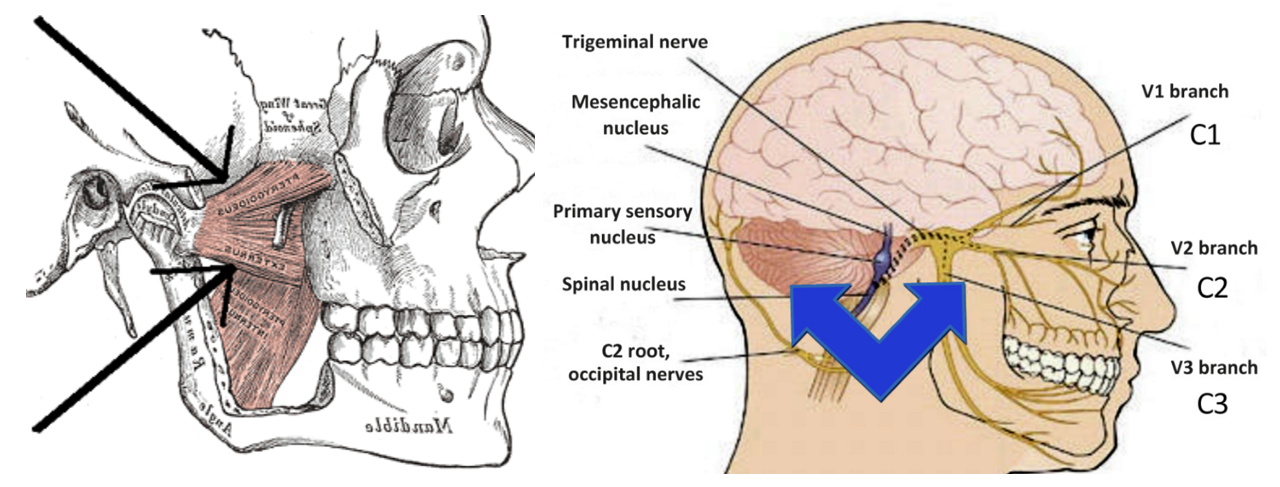Written By: David Denton, PT, DPT, EdD, CIDN, CVT
 Have you ever been chewing gum, bit into a pear, or tried to chew a well-done piece of meat and felt tightness in your jaw soon afterward? This small but mighty muscle, the lateral pterygoid, can cause a myriad of pain, dysfunction, and lifestyle changes when it is not working correctly. The lateral pterygoid (two heads) is one of the four mastication muscles (chewing). The muscle is responsible for depressing the mandible, moving the jaw into lateral deviation (side to side) during grinding while chewing, and opening the mouth fully during daily activities such as talking and eating. Knowing this muscle’s role and how to relax it can be the key to unlocking your jaw pain. Sometimes clicking or pain on one side is actually caused biomechanically on the OTHER side.
Have you ever been chewing gum, bit into a pear, or tried to chew a well-done piece of meat and felt tightness in your jaw soon afterward? This small but mighty muscle, the lateral pterygoid, can cause a myriad of pain, dysfunction, and lifestyle changes when it is not working correctly. The lateral pterygoid (two heads) is one of the four mastication muscles (chewing). The muscle is responsible for depressing the mandible, moving the jaw into lateral deviation (side to side) during grinding while chewing, and opening the mouth fully during daily activities such as talking and eating. Knowing this muscle’s role and how to relax it can be the key to unlocking your jaw pain. Sometimes clicking or pain on one side is actually caused biomechanically on the OTHER side.
Anatomy Overview
The lateral pterygoid muscle is a small but powerful muscle with two heads that originate from the sphenoid bone (superior head) and the lateral pterygoid plate (inferior head). The superior head inserts to the mandibular condyle and the inferior head to the pterygoid fovea with fiber attachment to the articular disc and fibrous joint capsule. It is also worth noting the importance and close connection to the trigeminocervico nucleus and the importance of a pain-free range of motion needed at C1/C2 (discussed later).
The articular disc is directly affected by the insertion of the small deep lateral pterygoid. Like a rubber band attached to a door, the lateral pterygoid can pull on the disc and encourage it to click, pop, or clunk during movement. As this begins to occur with each jaw opening, naturally the body tries to protect itself, (natural adaptation) tensing the muscles further and exacerbating the problem.
Lateral Pterygoid in “Knots”
It is estimated that we open our jaws approximately 2,000 times a day!! It is not surprising that when a problem happens (muscle fatigue/spasm), it is felt all day long, and during activities that we normally do not even think about. If a trigger point (similar to a knot) in the muscle becomes active, it results in immense pain, tenderness, and stiffness. The trigger point can lead to improper jaw biomechanics during normal motions, inflammation, and irritation of the articular disc.
Treatment for TMJ Problems
The good news is that a TMJ problem may go away on its own -eventually. If the pain and discomfort persist, a trained physical therapist may make the following recommendations to help ease your symptoms:
- Eat softer foods and avoid chewing gum (in the short term)
- Apply ischemic compression (internal and external) to trigger points
- Practice self-mobilization at the jaw
- Practice C1/C2 joint distraction
- 6x6x6 Rocobado Exercises
- Progressive Muscle Relaxation Techniques
- Wear a mouth guard
- Practice muscle relaxation exercises to reduce stress and lessen tension in your jaw muscles
- Dry Needling
Interested in learning more? Tune in to my upcoming Summit Live Webinar, Evidence-Based Assessment and Treatment for TMJ, Cervical Spine Dysfunction, and Headaches on Wednesday, July 12th. This interactive course will expand your manual practice toolbox which can branch out to include cervical dizziness, and TMD, and promote resources for a large subset of the population affected by postural and cervical headaches.
Explore continuing education courses from David below:
Evidence-Based Assessment and Treatment for TMJ, Cervical Spine Dysfunction, and Headaches
Clinical Application of Musculoskeletal Anatomy
Visit summit-education.com for more information.
References:
Liu MQ, Zhang XW, Fan WP, He SL, Wang YY, Chen ZY. Functional changes of the lateral pterygoid muscle in patients with temporomandibular disorders: a pilot magnetic resonance images texture study. Chin Med J (Engl). 2020;133(5):530-536. doi:10.1097/CM9.0000000000000658
Li C, Liu X, Muhetaer B, Jumatai S, Gong Z. Magnetic resonance imaging texture analysis of unilateral lateral pterygoid myospasm in patients with temporomandibular joint disorders: A pilot study. Digit Med 2021;7:2
Šedý J, Rocabado M, Olate LE, Vlna M, Žižka R. Neural Basis of Etiopathogenesis and Treatment of Cervicogenic Orofacial Pain. Medicina. 2022; 58(10):1324. https://doi.org/10.3390/medicina58101324

